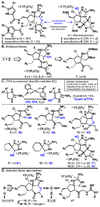Total syntheses of (+/-)-massadine and massadine chloride
- PMID: 19049446
- PMCID: PMC2913575
- DOI: 10.1021/ja8074852
Total syntheses of (+/-)-massadine and massadine chloride
Abstract
The total synthesis of the complex pyrrole–imidazole alkaloids (±)–massadine and (±)–massadine chloride is described using a carefully orchestrated sequence of manipulations on highly polar and structurally complex intermediates. Key to the completion of this synthetic endeavor was the exploration of a unique and chemoselective method to oxidize unprotected guanidines under aqueous conditions in air. This oxidation has been optimized and applied to a selection of spirocyclic guanidines of varying complexity. Additionally, the 3,7–epi analogues of these interesting natural products have been synthesized and fully characterized.
Figures


References
-
-
For original isolation, see: Kinnel RB, Gehrken H-P, Scheuer PJ. J. Am. Chem. Soc. 1993;115:3376. Kinnel RB, Gehrken H-P, Swali R, Skoropowski G, Scheuer PJ. J. Org. Chem. 1998;63:3281.. For reassignment of the original structure, see: Grube A, Köck M. Angew. Chem. Int. Ed. 2007;46:2320. Buchanan MS, Carroll AR, Addepalli R, Avery VM, Hooper JNA, Quinn RJ. J. Org. Chem. 2007;72:2309. Kobayashi H, Kitamura K, Nagai K, Nakao Y, Fusetani N, van Soest RWM, Matsunaga S. Tetrahedron Lett. 2007;48:2127. Buchanan MS, Carroll AR, Quinn RJ. Tetrahedron Lett. 2007;48:4573.
-
-
- Urban S, Leone P, de A, Carroll AR, Fechner GA, Smith J, Hooper JNA, Quinn RJ. J. Org. Chem. 1999;64:731. - PubMed
-
- Grube A, Köck M. Org. Lett. 2006;8:4675. - PubMed
-
-
For work done through early 2007, see the following reviews and references therein: Hoffmann H, Lindel T. Synthesis. 2003:1753. Jacquot DEN, Lindel T. Curr. Org. Chem. 2005;9:1551. Köck M, Grube A, Seiple IB, Baran PS. Angew. Chem. Int. Ed. 2007;46:6586.. Reports late 2007 to present: Lanman BA, Overman LE, Paulini R, White NS. J. Am. Chem. Soc. 2007;129:12896. Sivappa R, Hernandez NM, He Y, Lovely CJ. Org. Lett. 2007;9:3861. Tang L, Romo D. Heterocycles. 2007;74:999. Cernak TA, Gleason JL. J. Org. Chem. 2008;73:102. Wang S, Romo D. Angew. Chem. Int. Ed. 2008;47:1284. Bultman MS, Ma J, Gin DY. Angew. Chem. Int. Ed. 2008;47:6821. Zancanella MA, Romo D. Org. Lett. 2008;10:3685.
-
Publication types
MeSH terms
Substances
Grants and funding
LinkOut - more resources
Full Text Sources

